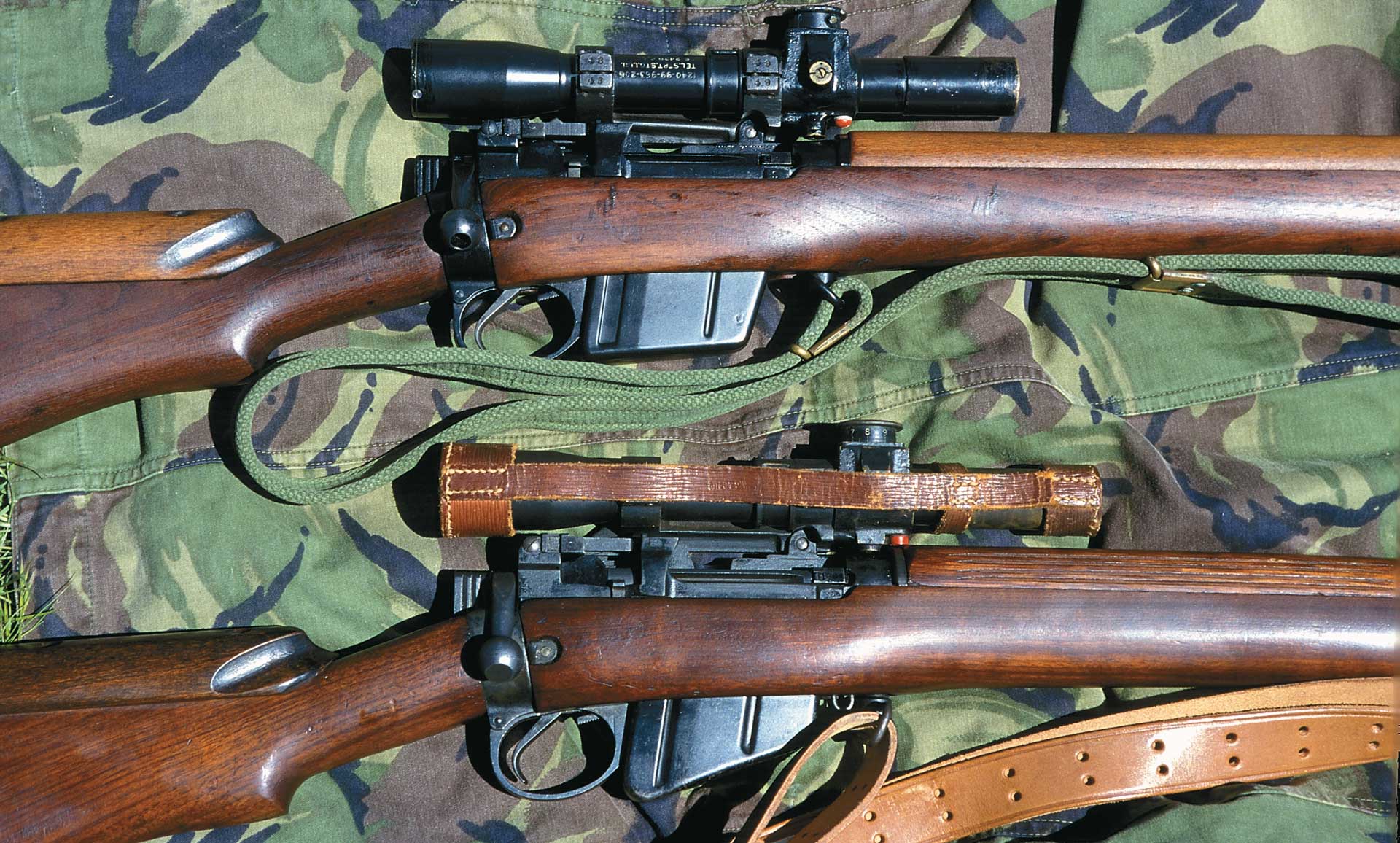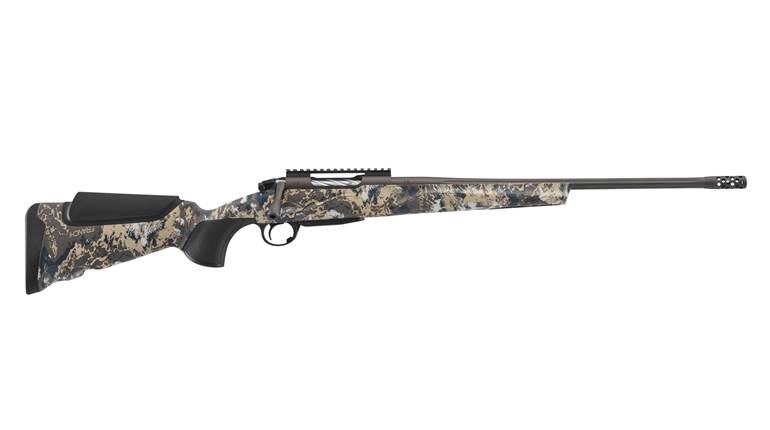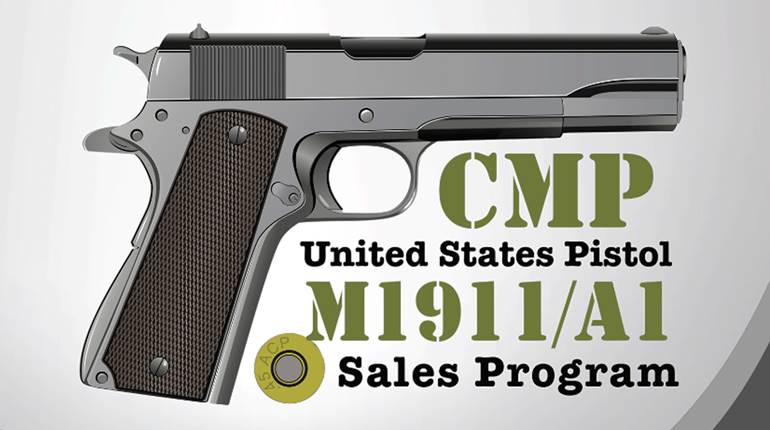
The author, editor of Guns Australia magazine, wishes to thank Robert Courtney and Mike Etzel of the Australian War Memorial, the late H. J. Woodend, formerly of the U.K. M.o.D. Pattern Room and Roger Matthews of the British High Commission in Canberra, Australia, for their assistance in the preparation of this article. —The Eds.
It is a tribute to the design and utility of the Lee-Enfield bolt-action that it was still in service with the British Army more than 100 years after it was first adopted. The first British service Lee was the Lee-Metford adopted in December 1888, while the last was the L42A1 sniper rifle, which was only declared obsolete in April 1992. In between came the famous No.1 Mk III Short, Magazine Lee-Enfield and its mass production-oriented successor, the No.4 rifle that served during and after World War II.
The L42A1 is a 7.62x51 mm NATO sniper rifle developed from the World War II-vintage .303 British No.4(T). The No.4(T) was Britain’s main sniper rifle of World War II and consisted of a carefully selected No.4 service rifle mated with a No. 32 telescopic sight that had originally been designed to go on the Bren light machine gun.

When the 7.62x51 mm round became the NATO standard, Britain adopted a version of the Belgian FN Fusil Automatique Legere (FAL), known as the Self Loading Rifle (SLR), as its standard issue individual rifle. While the SLR was to prove an excellent battle implement, its level of accuracy fell a long way short of that necessary for a sniper rifle. The .303 No.4(T) rifle soldiered on in this role until the early 1970s despite that fact that its ammunition had been officially “obsolete” for over 10 years.
The British had originally planned to convert a large part of their existing stocks of No.4 rifles to 7.62 mm for issue to rear-echelon troops, and both Sterling and Enfield manufactured kits for this purpose. For various reasons, including poor accuracy and reduced personnel numbers, the conversion process of the No.4 rifle to L8 specification was not fully pursued, but some work was done on an L8T sniper rifle version. These L8T prototypes, externally identical to the .303 No.4(T) except for the magazine, were tested extensively in 1965 but did not succeed and were never issued.
The disappointing results achieved with the L8T were at odds with the excellent shooting being done by rifle club members at Bisley and other target ranges around the world at that time with converted No.4 7.62 mm rifles. In target rifle form, the No.4 action was mated with a heavy-profile, commercially manufactured barrel mounted in a shortened fore-end as the heavier barrel did not require support. These innovations were not lost on the designers at Enfield who soon incorporated similar features into a prototype rifle called the XL42E1.

The XL42E1 was extensively tested in competition with offerings from various rifle and scope manufacturers, and was found to offer the best combination of reliability and accuracy. The fact that it could be manufactured by converting the stockpile of existing No.4(T) rifles may have had some bearing on the decision. With a few minor specification changes, the XL42E1 was christened the L42A1, and production commenced in 1970. The specification of the trial rifles and the eventual production rifles was almost exactly the same—so much so that at least a few XL42E1s were later found on issue as regular sniper rifles.
The conversion of the No.4(T) to L42A1 specification is not as simple as it may first appear. New parts included the barrel, magazine, extractor and top handguard, while modifications were required to the foresight block, action body, rear sight slide and fore-end. The telescopic sight also required recalibration to suit the trajectory of the 7.62 mm round, and these were refurbished as part of the recalibration process with their designation changing from “Telescope No.32 Mk III” to “Telescope, Straight, Sighting, L1A1.” The original designation can be seen barred out on the refurbished scopes. The iron rear sight was also altered to suit the new ammunition. An “M” is sometimes found on the rear sight and the range drum of the telescopic sight, which denotes metric conversion.

The barrel was a hammer-forged unit and has the “snakeskin” appearance peculiar to barrels made using that process. It was 27.5” long and made from high-quality EN19AT steel. Early barrels feature the traditional, sharp-edged Enfield rifling while later production could be found with more rounded off chordal rifling reminiscent of the original Metford system. This later type was cheaper and easier to manufacture when using the hammer-forging process.
The magazine was a completely new unit to cater to the 7.62 mm rimless round. The L42A1 used the Enfield pattern magazine with the ejector built onto the left rear magazine lip. This arrangement made the receiver-mounted screw ejector redundant, and this was usually left out. The receiver was slightly modified in the magazine well to ensure the correct fit of the magazine and reliable feeding of cartridges.
All L42A1s had undergone a rigorous reproofing procedure to ensure their safe operation with the newer and more powerful 7.62 mm round. The proof mark “19T” in company with crossed flags can be found on the bolt handle, bolt head and receiver of all genuine L42A1s. It indicates that those components withstood a proof pressure of 19 tons per square inch.
L42A1 Specifications:
Caliber: 7.62x51 mm NATO
Overall length: 46.5”
Barrel length: 27.5”
Rifling: four-groove, 1:12” RH twist
Weight: 10 lbs. (without scope)
Magazine: 10-round detachable box
Muzzle velocity: 2850 f.p.s.
Weight of scope: 2 1⁄2 lbs.
Magnification: 3X
Graduations: 100 to 1,000 meters
The L42A1’s fore-end was shortened, partly to save weight and partly because the heavier barrel does not require support. Some L42A1s appear to have been fitted with their original No.4(T) fore-ends suitably modified while others were fitted with new ones. A modified handguard from the No.8 .22 training rifle was used along with either a new or original butt and the same cheek rest as the No.4(T).
All L42A1s were based on existing No.4(T) rifles, some of which had seen a good deal of service. The front scope mounting pad screws of one rifle I examined have been restaked three times, indicating lots of hard service. Most of the original No.4(T) marks remain visible on the L42A1, even the obscure ones that tell the difference between an original and a fake.

The “T” stamping on the left of the receiver is sometimes missing on an L42A1 depending on how deeply the action was buffed prior to refinishing. Because the L42A1 is a conversion of the No.4(T), all are based on No.4 Mk I and Mk I* rifles. Any rifle purporting to be an L42A1 that is based on a Mk II receiver with its hung trigger should be treated with the gravest suspicion.
Each rifle and scope combination formed part of the Complete Equipment Schedule (CES) and, in common with the No.4(T), once the rifle and scope were paired they remained an item for the rest of their service life. The rifle’s serial number was stamped on the scope mounting bracket while the scope’s number was stamped on the small of the butt. The rifle and scope traveled in a large wooden chest with the scope further protected in a metal container. Included in the chest as part of the CES was a Scout Regiment telescope for observation and all the other equipment necessary to operate the rifle, such as cleaning gear, sling, user handbook and so on. There was also provision to store an “Individual Weapon Sight” (IWS) bracket. This terminology is confusing as the IWS is really a night sight.
An accurate production figure for the L42A1 proved to be an elusive target for a long time. Published texts contain estimates that “thousands” were built, but are unable to give specific numbers because, while the rifles were still front-line-issue British Army arms, these figures were classified. Thanks to the assistance of researchers at the Australian War Memorial and the U.K. M.o.D. Pattern Room (before that marvelous resource fell victim to bureaucratic cost cutting) a more accurate estimate is now possible.
The British Army’s Operational Requirements Branch stated a need for 840 rifles in September 1970, and included in that figure was an allocation to the Royal Marines. According to staff at the U.K. M.o.D. Pattern Room—who had access to contemporary Enfield files—this requirement was later increased to 892 rifles and progress documents dated February 2, 1972, record that 898 rifles had been assembled. The picture becomes a little blurred after that as delivery documents indicate that 967 rifles had been dispatched by November 7, 1973. There is also evidence that a further 40 rifles were delivered in 1975, 24 in 1976 and 18 in 1979. This amounts to a total of 1,049. However, a batch of rifles is known to have been produced in 1980, though no information is currently available as to its size. Given the small size of other later orders it is reasonably safe to assume that it, too, was a small batch and, coupled with the 30 or so XL42E1s produced, would have put total production somewhere between 1,100 and 1,200 rifles.

A batch of 637 rifles was sold to Navy Arms in the United States after the rifles were declared obsolete in 1992. According to a letter from the late Val J. Forgett, president and CEO of Navy Arms Co., Inc., to the Australian War Memorial dated October 10, 1994, most of those rifles were sold in their chests at $995 each, but all were missing the remainder of the CES. A surplus sale of that volume combined with the small number of rifles available privately in the United Kingdom suggests that a production figure of between 1,100 and 1,200 is a relatively safe number.
In the late 1970s, a dozen L42A1s along with the CES were imported into Australia for Army trials. Two of those rifles “lost” their telescopic sights, and there were 10 complete rifles in storage at Randwick Barracks in the early 1990s. At some point soon after the rifles arrived in Australia, the Scout Regiment telescopes were removed from the chests, possibly for use by Army snipers who were then still equipped with No. 1 Mk III High Mount .303 sniper rifles prior to the eventual issue of the Parker-Hale rifle in 1982.
Shooting an L42A1 is an impressive experience. Forget any prejudices you may have about inaccurate or inconsistent Lee-Enfield rifles—the L42A1 is as accurate as just about anything else for practical purposes. It is a very handy rifle at long range, too, and by long range I mean out to 900 yds., which is the longest range at which I have had the opportunity to fire one. There are accounts of accurate shooting out to 1,000 yards with an L42A1. Firing a competitive score against a modern Palma Match target rifle is a realistic proposition. An L42A1 is a carefully assembled, well-balanced rifle with a crisp trigger pull and an excellent (if low powered) telescopic sight. It represents the pinnacle of development for the renowned and enduring Lee-Enfield series of bolt-action rifles.

The L42A1 served with the British Army for nearly 25 years, and it reportedly gave excellent service wherever it was used. Deployments included such well-known destinations as the Falklands and Northern Ireland. Peter Laidler, a noted armorer and writer on the subject, has speculated about how many urban terrorists have fallen to the combination of an L42A1 and the Starlight night scope without ever knowing what hit them.
During the Falklands War between the British and Argentina in 1984 over the Falklands Islands in the South Atlantic, a particularly savage action was fought between the British 2nd battalion, Parachute Regiment, and the Argentines at Goose Green. It was arguably the longest and toughest battle of that brief but bloody war.
The British Paras numbered 600 and were up against 1,400 Argentine soldiers. They were fighting over open ground in daylight against prepared positions, were low on ammunition and lacked adequate fire support. The British won the fight but lost 17 of their soldiers against some 200 Argentine dead. Their L42A1 equipped snipers are known to have made a significant contribution to that grim toll.

The L42A1 was less fashionable but more consistent and reliable in the field that many of its contemporaries. During the trial process prior to its adoption it reportedly “shot them all into a cocked hat.”
Whatever else may be said of the L42A1, it was certainly a worthy rifle to be the last of the long line of Lee-Enfield bolt-actions that had served British and Commonwealth forces with such distinction for more than a century.
This article, “The Lee-Enfield,” appeared originally in the September 2004 issue of American Rifleman. To subscribe to the magazine, visit the NRA membership page here and select American Rifleman as your member magazine.






































